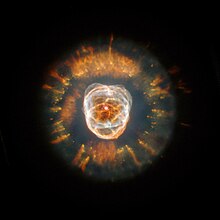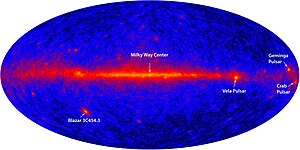Gemini (constellation)
Gemini (the twins) is the third constellation of the zodiac, and lies about thirty degrees northeast of Orion. William Herschel discovered Uranus near η Geminorum in 1781, and Clyde Tombaugh discovered Pluto near δ Geminorum.
Notable features
Pollux (β Geminorum) is the brightest star in Gemini. It is an orange giant —spectral type K0IIIb— and it is the closest star of these characteristics to the solar system, since it is at a distance of 33.7 light years. Around it an extrasolar planet 2.3 times more massive than Jupiter has been discovered with a separation of 1.64 au.
Castor (α Geminorum) is a multiple star with six components. The two brightest components are white main sequence stars —type A1V and A2Vm— whose orbital period is 445 years. Each of these stars is, in turn, a spectroscopic binary. A third, more distant binary—named YY Geminorum—completes the system: it consists of two red dwarfs and is an eclipsing binary.
The third brightest star is γ Geminorum, named after Alhena, a white subgiant and also a spectroscopic binary; the orbital period of this system is 12.6 years. Next in brightness is μ Geminorum (Tejat Posterior), a red giant of type M3III with a radius 104 times that of the Sun. Very similar is the main component of the stellar system η Geminorum (officially called Propus), although it is a more luminous giant but also more distant. Both μ Geminorum and η Geminorum are variable stars. υ Geminorum is also a red giant, although somewhat less cool, its spectral type being M0III.
Another variable of interest in the constellation is Mekbuda, the name given to ζ Geminorum, one of the few Cepheids observable with the naked eye and whose variability was first noticed by Johann Friedrich Julius Schmidt in 1847. For its part, Mebsuta is the name by which ε Geminorum is known, a yellow supergiant of type G8Ib also variable.
Wasat (δ Geminorum) is a multiple star composed of a subgiant of type F0IV and an orange dwarf of type K6V separated by at least 100 AU; in turn, the subgiant is a spectroscopic binary. Jishui —official name of ο Geminorum— is an F3III type giant 30 times more luminous than the Sun. 37 Geminorum is an interesting yellow dwarf with physical characteristics so similar to the Sun that it can be considered a solar twin. Of spectral type G0V and without any stellar companion, it has a mass of 1.1 solar masses and its radius is 3% larger than the solar radius. Its age is estimated to be about 4.470 - 4.5 billion years, very similar to that of the Sun.
In addition to the aforementioned variables, U Geminorum is part of Gemini, a binary made up of a white dwarf and a red dwarf so close to each other that the latter loses matter from its surface to the detriment of the white dwarf. It is a prototype of a class of cataclysmic variables called dwarf novae. On the other hand, the Mira R Geminorum variable is an S-type star and a technetium star (its spectrum reveals the presence of this short-lived element). TU Geminorum is a carbon star, one of the most luminous of its class; Since its distance is not well known, neither is its bolometric magnitude, so it radiates between 5,800 and 42,000 times more energy than the Sun in the combined electromagnetic spectrum. Another outstanding variable is OV Geminorum, a subgiant of type B6IV and a peculiar star whose anomalous chemical composition allows it to be included in two different classes: as a Bw star or star with weak helium lines, and as a mercury-manganese star.
At 18 light-years away, Gliese 251 is a red dwarf of spectral type M3V in this constellation. An extrasolar planet—of the "super-Earth" type—has been discovered that completes an orbit around this star every 14.2 days. Another star where a planet has been discovered is the K2III-type giant HD 59686; Said planet is at least 6.92 times more massive than Jupiter.
PM J07451+2627 is a white dwarf in Gemini, one of the coldest known, since its surface temperature is 3880 ± 60 K. Its age as a stellar remnant is approximately 7707 million years.
Geminga is located in this constellation, the name given to a pulsar that may be the remains of a supernova that occurred 342,000 years ago. That supernova could be responsible, at least in part, for the area of low density in the interstellar medium that exists in the vicinity of the solar system, known as the Local Bubble. The surface temperature of this remnant is 490,000 K.
The only object in the Messier catalog in Gemini is the open cluster M35, which has 120 stars of magnitude less than 13 and 513 possible members. It is located at a distance of 2,700 - 2,800 light years and has an intermediate age of around 100 million years. NGC 2420 is another open cluster that contains more than 300 stars. Unlike the Sun, it is about 3,000 light-years above the galactic disk, and since its average composition is similar to that of the Sun, it is surprising that it is in that location and not in the galactic disk. Its age is approximately 1.7 billion years.
The constellation has several planetary nebulae, such as NGC 2392 or the Eskimo Nebula. This has an estimated age of 10,000 years and is composed of two elliptical lobes of matter coming out of the dying star. Another planetary nebula is NGC 2371 or Gemini Nebula, which presents the appearance of an irregular disk; at its center is the core of a red giant, now stripped of its outer layers, whose surface temperature reaches 134,000 K.
IC 443, informally known as the Medusa Nebula, is a supernova remnant of mixed morphology. In the visible spectrum and at radio frequencies, it is shaped like a shell or shell, and consists of two interconnected sublayers, each of a different size and with a different center. The supernova that gave rise to this structure could have taken place 30,000 years ago. Even older is Monogema, another supernova remnant between 68,000 and 100,000 years old.
Main Stars
- α Geminorum (Cástor) is the second most brilliant star of constellation (visual image 1,58). It is given the circumstance that Cástor is actually a six-star multiple star system only discernible with powerful telescopes.
- β Geminorum (Pólux), the brightest star of constellation (magnitude 1,16), an orange giant 36 light years from the solar system.
- γ Geminorum (Alhena), the third brightest with magnitude 1,93, a spectroscopic binary star formed by a white subgigant accompanied by a yellow dwarf.
- δ Geminorum (Wasat), binary system of one yellow star and another orange, which can be solved with a small telescope.
- ε Geminorum (Mebsuta), yellow supergigante of magnitude 2,98 which is found in the right leg of the cloister twin.
- ج Geminorum (Mekbuda), cefeida whose brightness fluctuates between magnitude 3.7 and 4.2 in a ten-day period.
- η Geminorum (Tejat Prior), star system where the main star is a semi-regular variable whose magnitude ranges between 3.2 and 3.9.
- ι Geminorum, yellow giant of magnitude 3.80.
- κ Geminorum, binary composed of a yellow giant and a solar analogue.
- λ Geminorum, star system of magnitude 3,58 whose main component is a white star of the main sequence.
- μ Geminorum (Tejat Posterior), the fourth brightest with magnitude 2,87, red giant and irregular variable. Interesting for visual or prismatic observation.
- Geminorum, multiple star of magnitude 4,14 and star Be.
- φ Geminorum (Alzir), of magnitude 3.35, a yellow subgiant at 57 light years.
- Geminorum, white-yellow giant of magnitude 4,90.
- ρ Geminorum, star system of magnitude 4,16 whose main component is a white-yellow star.
- σ Geminorum, variable star RS Canum Venaticorum.
- τ Geminorum, orange giant of magnitude 4,40.
- Geminorum, a red giant of magnitude 4.08.
- φ Geminorum, white star of magnitude 4,98.
- 1 Geminorum, multiple star system of magnitude 4,15 that marks the position of the summer solstice.
- 37 Geminorum, yellow Sun twin dwarf and object of great interest in whether there is life in its surroundings.
- 51 Geminorum (BQ Geminorum), red and semi-regular giant of average magnitude 5.07.
- 57 Geminorum, yellow giant of magnitude 5.04.
- R Geminorum, star type S and variable Look with a period of 369.91 days.
- U Geminorum, archetype of a type of variable star, the dwarf novas.
- TU Geminorum, carbon star of an intense red color.
- BN Geminorum, blue star of variable brightness between magnitude 6.75 and 6.85.
- BU Geminorum (6 Geminorum) and TV Geminorum, distant red supergiant; the first is an irregular variable of average magnitude 6.38.
- GX Geminorum, eclipsing binary whose two components are abandoning the main sequence.
- OT Geminorum, distant Be star of magnitude 6.45.
- OV Geminorum (33 Geminorum), mercury-manganese star and Bw star of magnitude 5.87.
- HD 52711, yellow dwarf of magnitude 5,93 distant 62 light years.
- HD 59686, giant orange with an extrasolate planet around.
- Gliese 251, red dwarf at 18.15 light years of the solar system.
- Geminga, a pulp that emits gamma rays and X-rays; it is thought to be the rest of a supernova that exploded 300 000 years ago.
Deep Sky Objects
- Open volume M35 or NGC 2168, easily visible with prismatics: through any telescope it is formed by a large number of mid bright stars.
- Very close to M35 and in clear contrast to it, the NGC 2158 cluster, much older and farther.
- Open Cluster NGC 2420, 4th east of Wasat (δ Geminorum).
- NGC 2392 or Eskimal Nebula, of magnitude 10 with a brilliant central star.
- The great planetary nebula NGC 2371.
- Abell 21 or Nebula Medusa, large and ancient planetary nebula, 5 arcmin in diameter.
- IC 443, nebula diffuse remnant of a supernova, near Tejat Prior (Music Geminorum).
- Monogema, former remaining supernova probably associated with the PSR B0656+14.
Mythology
In Greek mythology, the twins are Castor and Polideuco (Pollux, for the Romans). They were born from an egg laid by Leda, the queen of Sparta, after having copulated with Zeus turned into a swan. Castor, the mortal, was the son of King Tyndaro; the immortal Polydeuchus was the son of Zeus.
Both participated in several collective feats: in the hunt for the Calydonian boar and in the voyage of the Argonauts, among others.
The twins had a dispute with their cousins Idas and Lynceus. Idas (the immortal cousin) killed Castor with a spear, to which Polideuco, despite his wounds, responded by killing Lynceus. Zeus intervened and struck them down with lightning.
Polydeucus rejected his immortal status if he could not share it with Castor. Therefore, Zeus made a pact with his brother Hades, in which the brothers could spend six months on Olympus and another six in the kingdom of Hades.
Contenido relacionado
(109) congratulations
(102) Miriam
Lyman Spitzer Jr.







